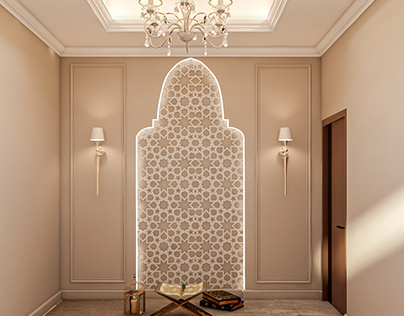Finding a personal space for prayer and meditation can be incredibly fulfilling. In my own journey, creating a cozy prayer room has allowed me to deepen my spiritual connection and find peace amidst the chaos of daily life. Whether you’re looking to convert a spare room, a corner of your home, or even a small nook, I’m excited to share various decoration ideas that will inspire you to cultivate your sacred space.
Why You Need a Dedicated Prayer Room
Having a designated area for prayer and reflection offers numerous benefits:
- Enhanced focus and tranquility
- A personal retreat from the world
- Increased spiritual practices
- A place for meditation and mindfulness
Choosing the Right Space for Your Prayer Room
Before diving into decoration ideas, it’s crucial to choose the right space. Consider the following:
Factors to Consider
- Lighting: Natural light can enhance the ambiance.
- Size: Even a small corner can be transformed with the right elements.
- Noise Levels: A quiet area will help you focus on your practice.
- Aura: Choose a place that feels good to you, where you feel at peace.
Essential Prayer Room Elements
Regardless of your design preferences, there are fundamental elements every prayer room should include:
Altar or Prayer Table
Your altar is the centerpiece of your prayer room. Here are some ideas to decorate it:
- Use a small, elegant table or shelf.
- Adorn it with meaningful items such as candles, scriptures, or personal tokens.
- Consider incorporating plants for a touch of nature.
Comfortable Seating
Having a comfortable spot to sit during your prayer sessions is essential. Consider options like:
- Floor cushions or meditation mats
- A small chair or bench
- Bean bags for a relaxed vibe

Lighting Options
Lighting sets the mood in your prayer room:
- Use soft, warm light fixtures.
- Add candles for an intimate ambiance.
- Consider string lights for a whimsical touch.
Decorative Themes for Your Prayer Room
Your prayer room can reflect your personal style. Here are some popular themes:

Minimalistic Feng Shui
This style emphasizes simplicity and harmony:
- Use neutral colors like white or beige.
- Incorporate natural elements such as bamboo or stones.
- Keep decorations to a minimum to encourage serenity.
Bohemian Vibe
Perfect for those who love vibrant colors and eclectic designs:
- Use colorful textiles and patterned rugs.
- Incorporate various types of art and wall hangings.
- Add plants for a fresh, lively atmosphere.

Calm Coastal Retreat
Utilize colors and textures that evoke the sea:
- Opt for blues, whites, and sandy tones.
- Incorporate driftwood or seashell decor.
- Keep decor light and airy for a peaceful feel.
Personal Touches to Enhance Your Space
Adding personal touches can make your prayer room truly special:

Incorporate Personal Artwork
Consider displaying artwork that resonates with your spiritual journey. Whether it’s your own creations or pieces that inspire you, personal art adds a unique touch.
Add Meaningful Quotes
Hang framed quotes or scriptures that inspire you. This not only beautifies your space but also reinforces positive thinking.

Use Scent to Enhance the Experience
Scents can be very powerful. Use aromatic candles, incense, or essential oil diffusers to create a calming atmosphere.
Comparison of Different Prayer Room Styles
| Style | Description | Pros | Cons |
|---|---|---|---|
| Minimalistic Feng Shui | Simple, clean lines with focus on harmony. | Promotes tranquility, easy to maintain. | Might feel too stark for some. |
| Bohemian Vibe | Eclectic and colorful, filled with textures. | Creative and expressive, personalized. | Can feel cluttered if not organized well. |
| Calm Coastal Retreat | Light and airy, reminiscent of the ocean. | Refreshing and soothing; great for relaxation. | May require more decoration to achieve desired effect. |

Pros and Cons of Creating a Prayer Room
Pros:
- Provides a dedicated space for spiritual practices.
- Encourages mindfulness and relaxation.
- Can enhance personal growth and reflections.
Cons:
- Requires time and effort to decorate thoughtfully.
- May need to deal with distractions from family or clutter.
- Space may be limited in smaller homes.

Incorporating Technology in Your Prayer Room
In today’s world, incorporating technology can complement your practice:
Use of Meditation Apps
Consider integrating meditation apps for guided sessions. These can enhance your experience, especially if you’re new to meditation.
Speakers for Ambient Sound
Using a Bluetooth speaker, you can play calming sounds or spiritual music to enhance your environment.
FAQs About Decorating a Prayer Room
1. What colors are best for a prayer room?
Soft, calm colors like beige, blue, or pastel shades promote tranquility and focus. However, choose colors that resonate with you personally.
2. How can I make a small space feel larger for a prayer room?
Use mirrors to create the illusion of space, opt for light colors, and choose compact furniture to maximize your area.
3. Can I use multi-functional furniture in my prayer room?
Absolutely! Multi-functional furniture like storage benches or foldable tables can make your prayer room more versatile and organized.
4. What type of flooring is best for a prayer room?
Soft flooring options like carpet or rugs can create a cozy atmosphere. If you prefer hardwood, adding plush area rugs can provide comfort.
Conclusion: Transforming Your Prayer Room
Creating a prayer room is a rewarding endeavor that allows you to connect more deeply with your spirituality. By incorporating thoughtful decoration, personal touches, and your unique style, you can cultivate a serene sanctuary that encourages prayer and reflection. Remember, it’s not just about the looks; it’s about creating a space where you feel at peace and can grow spiritually.
May your prayer room be a source of light, peace, and inspiration in your life!